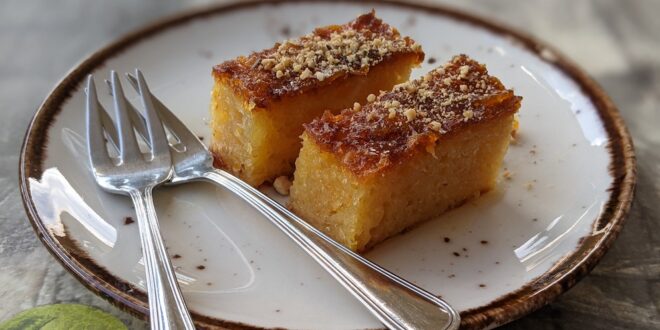Pastitsio
This authentic Greek food, popular on Corfu and the Ionian islands, has a distinctly Italian flavour. This yummy dish is made up of layers of minced meat in a tomato sauce, separated by layers of creamy pasta in béchamel sauce. Sound familiar? Pastitsio is often referred to as the ‘Greek lasagne’, but there are a few differences: the tomato sauce is spiced with clove and cinnamon, while the pasta used is more like a tube of macaroni than a flat sheet.
Pastitsio in its present form was created in the 1920s by the French-trained Greek chef Nikolaos Tselementes, best known for adding béchamel sauce to moussaka, unofficially Greece’s national dish. Pastitsio is a popular Sunday lunchtime dish, but you can grab a plate any day of the week in any Greek restaurant worth its salt.
Revithada
The signature dish of Sifnos – a Cycladic paradise covered in rocky terraces and 365 churches – is Revithada, a slow-cooked chickpea stew. Dried chickpeas, white onions, sage and bay leaves are tossed into a clay pot called a skepastaria, which is sealed with a ring of dough so that steam doesn’t escape.
Then, the clay pot is placed in a wood-fired oven for a minimum of 6 hours. It’s said this staple of Greek cuisine dates back to 3,000 BC when the wives of Sifnian potters stewed the dish overnight so they could have a day off from cooking. And what a reward Revithada is – the tender chickpeas take on a toasty, herby flavour by the time the lid is lifted.
Tomato keftedes
Although Greece’s menus are full of vegetable fritters – from zucchini and pumpkin to aubergine – these delicious little balls of fried tomato goodness hail from superb Santorini. Usually eaten as part of an impressive mezze spread (a type of Greek food that’s very moreish), tomato keftedes are fritters made from vine-ripened Santorini cherry tomatoes, grown in the island’s nutrient-rich volcanic soil and famed throughout Greece for their deep red hue and sweet-on-the-tongue taste.
The tomatoes are chopped and then mixed with onion, feta, mint, parsley and more punchy herbs. Then, the cook adds flour and water and fries dollops of the mixture in only the finest quality Greek olive oil. It’s easy to eat tomato keftedes until you’re full, but don’t forget to save space for your main course.
Mastelo
If you like halloumi, you’ll love Mastelo. This milky cheese from Chios – a shrub-covered isle in the north Aegean – is perfect for grilling, and gets those amazing, crunchy brown marks from the barbeque. It’s a little less salty than halloumi, and comes in a round shape, meaning your Mastelo burgers are basically ready-made (though perhaps not the most authentic Greek food).
In Chios, Mastelo cheese is made from cow’s milk, which is collected in its namesake wooden bucket – a ‘Mastelo’. Once matured and ready to eat, locals love chewy Mastelo inside a hot, to-go gyros wrap. You can also eat it raw, dressed with olive oil and balsamic vinegar: a scrumptious snack when paired with a phenomenally juicy Greek salad.
Portokalopita
In Greek, “portokali” means “orange” and “pita” is pastry, which sums up the two main components of this slice of sweet stuff: dried-out filo pastry dough (often leftover from making other Greek dishes) is shredded and mixed with Greek yoghurt, orange juice and egg.
An orange syrup is then poured generously over the traybake, and once the portokalopita is cooked it’s left for a full day, so the syrup is fully sucked up by the pastry. What’s left is a truly scrumptious sponge-like dessert, best served with an earthy Greek coffee or a herby cup of mountain tea. Greece’s best orange-growing regions include Crete, the Peloponnese and Arta in Epirus, so if you travel here in summer prepare for a flavoursome adventure.
Trigona Panoramatos
The zacharoplasteia (patisseries) of Thessaloniki – the food capital of Greece – are always filled to the brim with custardy delights, including bougatsa, the city’s quintessential breakfast. But visit Thessaloniki’s hilly Panorama suburb to try a piece of triangular heaven.
The trigona is a piece of Isoceles-shaped filo pastry filled with a vanilla-infused yellow crême (which seems to squeeze out of its pastry casing, but rarely gets messy, even in the heat of the Greek sun). Rich and crunchy at the same time, your delicious trigona can be topped with chopped nuts, or simply sprinkled with cinnamon: head to Trigona Elenidis on Thessaloniki’s bustling Tsimiski road to try it your way.










Join the Discussion
Type out your comment here:
You must be logged in to post a comment.